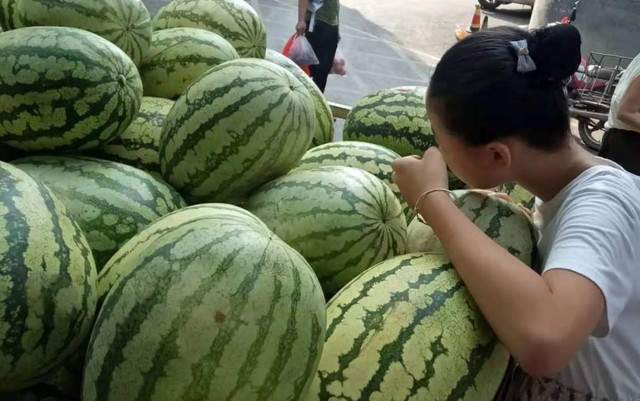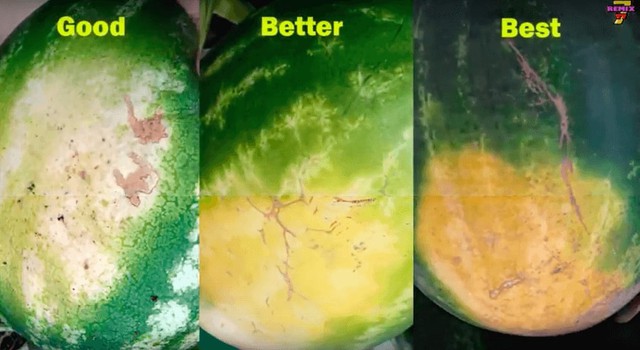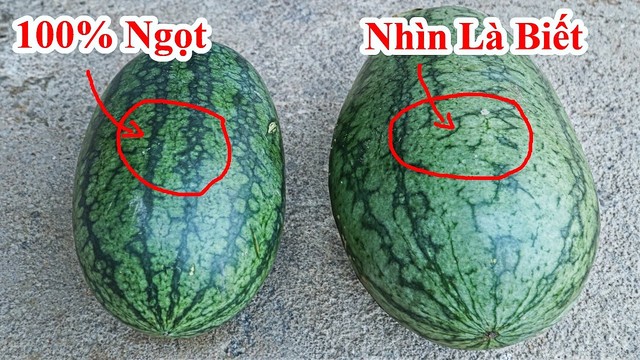• Not everyone knows how to differentiate the sound of a ripe watermelon when knocked on.
• A watermelon with a beautiful, evenly colored rind is not necessarily a tasty one.
• Adding something extra to the outside of the watermelon can help keep it fresher for longer.
As summer approaches, families’ demand for buying and enjoying fruits increases. To beat the heat, a familiar fruit that is suitable for all ages, easy to eat, and reasonably priced is the watermelon.
Usually, to choose a ripe, sweet watermelon that is not overripe, the most popular method is to knock on its body. If the watermelon produces a dull thud, it indicates that it is overripe and has a sharp sweetness. If the sound is sharper, then it is an unripe, bland watermelon.
There is also another type of sound, a “boop-boop” kind of sound. This indicates that the watermelon is past its prime ripeness, and its flesh may have turned mushy. It is not advisable to buy this watermelon.

The common method of knocking on a watermelon to test its ripeness (Illustrative image)
However, according to experienced individuals, there is more to selecting a sweet watermelon than just this knocking technique. Consumers can observe some details on the watermelon’s body to make a better choice.
Details that Indicate a Ripe Watermelon
1. The Bottom of the Watermelon
First, observe the bottom of the watermelon, specifically the color of this part. The bottom of a watermelon usually touches the ground and tends to have a yellow color. So, if it is yellow or yellowish-orange, or even brownish, it means the watermelon is ripe and sweet. If it is white or lighter in color, the watermelon will not be as tasty.

The ripeness of a watermelon can be determined by the color of its bottom, from left to right (Illustrative image)
2. The Stem, Top, and Belly Button of the Watermelon
After checking the bottom, turn the watermelon over to observe its stem. A ripe watermelon will have a small, withered stem. Especially if the stem is curled, it is even better, as long as it is still firmly attached to the fruit.
If the watermelon has a large, long stem that is not withered or curled and still looks fresh in color, it means the watermelon was picked too early and is unripe. If you buy this watermelon, you will need to let it ripen for a long time before consuming it.

The more curled and withered the stem of a watermelon is, the riper and sweeter it is (Illustrative image)
In some special cases, if the watermelon no longer has a stem when displayed in the store, observe the top or the opposite side, called the belly button. First, for round watermelons, the deeper the indentation at the top or belly button, the riper and sweeter the watermelon, and it has reached its prime ripeness.
On the other hand, for oval-shaped watermelons, the indentation at the top or belly button should be moderate. If it is too deep, it means the watermelon is overripe, and its flesh may have turned mushy.
3. The Rind of the Watermelon
Observe the overall appearance of the watermelon’s rind to make your final judgment. Specifically, the riper the watermelon, the smoother its rind will be, and the more distinct the veins will appear. If the rind doesn’t have very distinct veins and instead has black patches, they should be a deep black with a sheen.
You can also check for brown spots or bee stings on the watermelon. If there are many scattered spots, it means bees have interacted with this watermelon multiple times. The more pollination, the sweeter the watermelon.

Observing the veins on the watermelon’s rind can also help determine its ripeness (Photo by Lê Văn Lộc)
In addition to the above three characteristics, which help consumers easily identify a ripe and delicious watermelon, Eatthis, a specialized website, also points out another trick to differentiate watermelons. It is about observing the position of the watermelon when displayed on the shelves in supermarkets or fruit shops or agencies.
Usually, watermelons are placed in a separate area, away from other types of fruits, due to their large size. However, if you see some watermelons placed near bananas or other fruits that produce ethylene gas, it means those watermelons are too unripe and may be undergoing forced ripening. Additionally, the presence of ethylene gas increases the risk of the watermelons spoiling.
HOW TO STORE WATERMELON AT HOME: After choosing a ripe, sweet watermelon, don’t forget to pay attention to how to store it properly. According to experts, to store watermelons for the longest time, up to a month, create a protective layer outside the watermelon.
You can put the watermelon in a zip bag, plastic bag, or wrap it with 1-2 layers of food wrap and then place it in the dedicated fruit compartment in the refrigerator.
If you store the watermelon at room temperature, avoid exposing it to direct sunlight and keep it in a cool, dry, and well-ventilated place. However, watermelons stored this way will only last for about a week.
For cut watermelons, it is best to store them in the refrigerator, either in the freezer or the cooler compartment. Place the cut watermelon in an airtight container to prevent the watermelon from losing water, becoming mushy, and losing its taste.
During the hot summer days, you can take advantage of watermelons to make delicious dishes for your family, such as ice cream, smoothies, and more.
According to Nguoiduatin
9 Gorgeous Ways to Decorate a Mid-Autumn Festival Table
With the traditional Mid-Autumn Festival comes a long-time beloved activity – breaking the tray! Every year, children look forward to this exciting event, and what makes it even more fun is the brightly-colored, fruit-laden trays that make for an unforgettable childhood memory. If you’re interested in creating your own beautiful Mid-Autumn tray this year, then let us show you some of our favorite decorations!



































